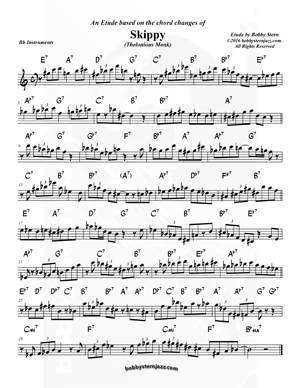Monk’s “Skippy” - The Etude

Monk's only recording of "Skippy" was from the 1952 Blue Note session that was released as part of "The Genius of Modern Music, Vol. 2", and which included an alternate take of the tune, as well.
As I've mentioned elsewhere, composing an etude for oneself can be extremely beneficial, in that it slows down the improvisational process and allows one to better see, hear and comprehend certain melodic and harmonic connections and how they tend to resolve - or not.
It's kind of like transcribing your own mind.
As the defining characteristic of a dominant 7th chord is the tritone between its 3rd and b7th (C7 = E & Bb, and its tritone sub; F#7 = A# & E), and being that there are only 2 beats per chord for the bulk of the tune (one beat per chord in measures #25-28), I've included the tritone melodically for each chord, in most cases, usually as part of a 2, 3 or 4 eighth note grouping; of which there are more than a few possibilities.

The 3 note shape that makes up the first three dominant chords (D7, G7, C7 concert) is highlighted in yellow in the above graphic. It transposes down chromatically (with slight variations in rhythm) for the first measure and a half, and each chord has a single note placed between its respective tritone.
In the case of the D7, it's a Bb (b13 or +5) between the F# (3) and C (b7) tritone. The symbol for this type of chord usually reads D7+5, referring to an augmented 5th, but I'll stick with b13 this time.
For the next chord, G7, the figure transposes down chromatically, but the root cycles down a perfect 5th. The F becomes the b7 and is on the bottom while its tritone B, is the Maj 3rd and on top. The A, as natural 9th in this case, is placed in between the two.
Had the root also moved down chromatically, in parallel with the rest of the figure, we would have simply had a Db7 (b13), the tritone sub of G7, with the exact same interval relationships as the previous chord.
In measure #2, the 3 note figure again moves down chromatically. The root resolves once more to the next V7 (C7) in the cycle of 5ths. The 3rd (E) is again on the bottom while the b7 (Bb) tritone is on top. The b13 (Ab) is, as before, caught in the middle.
While this 3 note figure could be derived from several scale systems, the most obvious choice would be the whole tone scale (a favorite of Monk's); followed by melodic minor (a favorite of mine). They are both excellent choices for conveying the 7 b13 (or 7+5) sound.
Speaking of melodic minor, the two 4 note groups in measure #3 (purple highlight) which make up Bb7 and A7, are derived from that scale (as well as from the Major scale system). This configuration yields a D Maj 7#11/ Bb, better known as Bb7 #9 b13 (see graphic for note labels), and moves down a half step in parallel (including its root), to A7 #9 b13, the tritone sub of Eb7, the next point in the cycle of 5ths.
The cycle continues chromatically with a descending Ab7 9 arpeggio in measure #4, connecting in anticipation to the b7 (B) of the next cycle point, Db7. The 4 note ascending figure (green highlight) in whole steps (b7-1-2(9)-3, in terms of the root) is an important one, which was often utilized at one point by a well known, former Monk disciple named John Coltrane, as part of his legacy, which became known as "Coltrane Changes".
As previously mentioned, there are more than a few ways to place melodic content in and around a tritone. Some other configurations in this etude are:
b7-1-2-3 (G7) & (F7) meas. #5
3-#4-#5-b7 (Ab7) same as b7-1-2-3 (D7) tritone sub - meas. #7
3-#4-b7-1 (G7) meas.#8
b5-3-1-b7 (F#7) meas.#9
3-2-b7 (E7) meas. #10
b7-6-b7-3 (Ab7 & G7) meas. #11
Can you find any others?
Both the melody and harmony from those 2 bars are derived from the E Melodic Minor scale system.

 RSS Feed
RSS Feed








